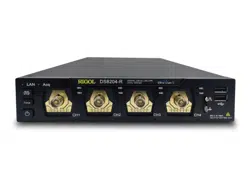Loading ...
Loading ...
Loading ...

RIGOL Chapter 11 Protocol Decoding
11-6 DS8000-R User Guide
oscilloscope to "STOP". You can export time and the corresponding
decoded data. Click Export, the save setting menu is displayed. You
can export the data table of the packets to the internal or external USB
storage device (when detected) in CSV format. For detailed saving
operation, refer to descriptions in "Store and Load".
➢ Jump to: Set the operating status of the oscilloscope to "STOP". Then,
select the data of the specified time from the event table. Click Jump
to and the specified data waveforms are displayed in the center of the
screen.
➢ Decode: The setting of this menu enables you to quickly view the
corresponding event tables of four decode modules (Decode1,
Decode2, Decode3, and Decode4). Click Decode to select a decode
module.
5
. Noise rejection
Click Settings → Noise Reject to enable or disable the noise rejection
function. Noise rejection can remove the data that last not enough time on the
bus and eliminate the burst glitch in the actual circuit. When the noise rejection
is enabled, click Reject Time, then use the pop-up numeric keypad or scroll
with the mouse to set the desired rejection time. The available range of the
rejection time is from 0 s to 1 s.
RS232 Decoding (Option)
RS232 serial bus consists of the transmitting data line (TX) and the receiving data
line (RX).
DeviceA DeviceB
Tx
Rx
Rx Tx
Figure 11-3 Schematic Diagram of RS232 Serial Bus
The industry standard of RS232 uses "Negative Logic", i.g. high level is logic "0" and
low level is logic "1".
1
0 0 0 0
1 1 1 1 1
Figure 11-4 Schematic Diagram of Negative Logic
In RS232, baud rate is used to represent the transmission rate (namely bits per
second) of the data. You need to set the start bit, data bits, check bit (optional), and
Loading ...
Loading ...
Loading ...
